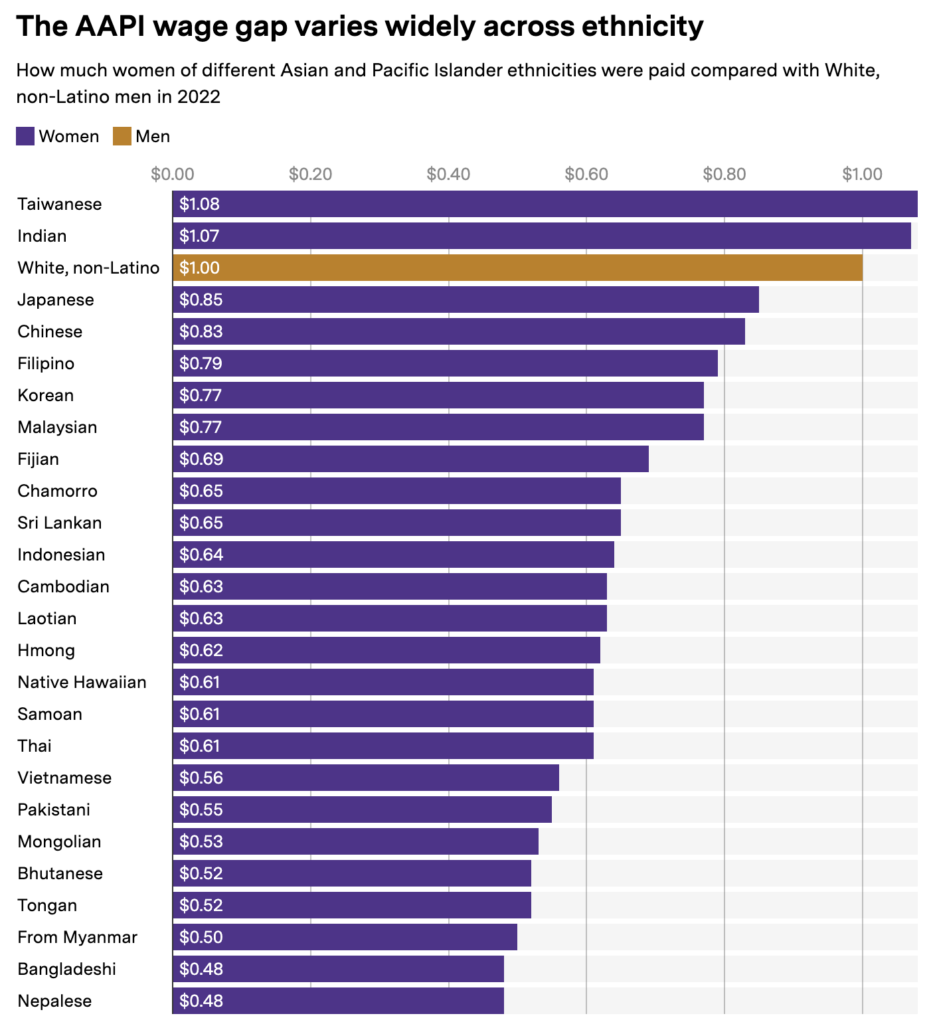Women's Rights & Issues
Related: About this forumWhy the Wage Gap Differs Among Asian American Women
(a lengthy, informative, disheartening read)
Why the Wage Gap Differs Among Asian American Women
4/5/2023 by Chabeli Carrazana, The 19th and Jasmine Mithani, The 19th
Under the AAPI umbrella, there are some of the highest earners among women—and the lowest. That obscures the economic realities of Southeast Asian, Native Hawaiian and Pacific Islander women.

A fruit stand in Chinatown, Lower Manhattan. AAPI women work disproportionately in healthcare, service and retail jobs, salon and nail tech positions and as personal care aides, including as hairdressers and childcare workers. In those jobs, they typically earn less than their white male counterparts. (Jeffrey Greenberg / Universal Images Group via Getty Images)
This story was originally published on The 19th.
Sparse economic data on Asian American, Native Hawaiian and Pacific Islander women has painted an inaccurate reality of economic well-being and hampered communities’ efforts to address disparities. It’s an issue that Wednesday’s AAPI Women’s Equal Pay Day—April 5, 2023—attempts to spotlight. On average, AAPI women earn 80 cents for every $1 earned by white men when looking at both full- and part-time workers, more than any other racial group of women. But that figure obscures the harsher realities faced by Southeast Asian, Native Hawaiian and Pacific Islander women, who see some of the largest wage gaps in the country.The 80 cent average captures an enormous range: Taiwanese women earn more than white men, about $1.08 for every white man’s $1, while Nepalese women earn 48 cents on the dollar. The AAPI umbrella encompasses the varied experiences of people across continents and oceans, missing the unique experiences of those communities in the United States.

Calculations based on 2017-2022 American Community Survey five-year estimates using IPUMS-USA data. Figures are based on women’s and men’s median earnings for all full- and part-time workers. White, non-Hispanic men typically made $51,790. Respondents to the American Community Survey self-identify their sex as either male or female and self-identify their race or whether they are of Hispanic, Latino or Spanish origin. (National Women’s Law Center analysis of University of Minnesota IPUMS-USA data / Jasmine Mithani)
Stereotypes about AAPI communities have undermined efforts to make the case for better data collection, said Yvonne Hsu, the chief policy and government affairs officer for the National Asian Pacific American Women’s Forum. “The ‘model minority’ myth that has been assigned to our community—that Asians do well and Asians are successful—when you look at the numbers dis-aggregated by ethnic groups, you can just see that is just flat out not true,” Hsu said.
In reality, AAPI women are over-represented in low-wage work. They are 3.8 percent of frontline workers though they are 2.9 percent of the overall workforce, according to a study by the National Women’s Law Center. They also work disproportionately in health care, service and retail jobs, salon and nail tech positions and as personal care aides, including as hairdressers and child care workers. And in those jobs, they typically earn less than their white male counterparts, said Jessica Mason, a senior policy analyst with the National Partnership for Women and Families.
“And on the other hand, they are underrepresented in a lot of higher paying jobs, or within those jobs, maybe they have some entry into STEM fields, but they really face a lot of barriers to advancing into higher levels of those fields,” Mason said. Even when they do have access to higher paying jobs, discrimination—gender, racial or both—blocks them from advancing, Mason said. But because sample sizes in national surveys are so small, it’s hard to dis-aggregate that data further to understand exactly which jobs, rather than larger job categories, communities are working in. It gets even harder to do when you layer gender, as well.
. . . . .
Understanding what sets NHPI women back is understanding that they are facing “a multitude of layered oppressions,” Owoimaha-Church said. “We live these intersectional lives and it’s that stacked on or layered with not having language access to different resources.” Unraveling those realities will be crucial to helping NHPI women prosper, she said. So will questioning why these groups of women are so far behind their Asian women counterparts in the first place. “What happens when we frame the conversation differently? Not about chasing where a white man is,” she said. “I struggle with justifying continuing to frame the conversation in this way. Since we are dealing with the lack of equitable data disaggregation, my first thought is, ‘PI women compared to Asian American women and what is that disparity and how do we first remedy that?’”
https://msmagazine.com/2023/04/05/asian-women-aapi-equal-pay-wage-gap/